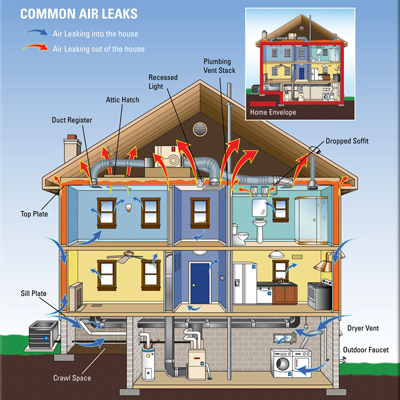Facts and Benefits: Save Your Energy AND Money!
Imagine opening a window in your house and leaving it that way 24 hours a day, all year long. On balmy spring days, the breeze wouldn't be so bad. But, in the freezing cold of winter and the sticky heat of summer, with the furnace or air conditioner on, smart homeowners would recognize they might as well be throwing buckets of quarters out the window to pay for the escaping heated or cooled air.
Your house is a system and every component in it works together. Adding insulation and sealing air leaks can improve the energy efficiency of your home and improve your home's comfort and durability. However, every change you make to the building's envelope (walls, floors, and ceiling) and components will affect how the home works to keep out the elements and keep your family safe and comfortable.
Tightening the building envelope without providing appropriate ventilation can cause pressure imbalances or negative pressure in the house. This negative pressure can set up the conditions for backdrafting of fireplaces or fuel-burning (combustion) appliances and may draw pollutants into the home. A trained contractor understands how systems work together to keep your house operating as it should.

BPI (Building Performance Institute) is one of two nationally recognized energy certifications for home energy auditors and contractors.
BPI is a nonprofit organization that accredits auditors, contractors, and other building professionals. Auditors or building analysts specialize in evaluating building systems and potential energy savings in homes. The certified BPI Building Analyst energy auditor has passed both written and field exams, and must recertify every three years. Contractors learn about building systems and are trained to install energy-efficiency measures. For more information see www.BPI.org.
The first step to taking a wholehouse energy efficiency approach is to find out which parts of your house use the most energy. A home energy audit will pinpoint those areas and suggest the most effective measures for cutting your energy costs.
Warm air leaking into your home during the summer and out of your home during the winter can waste a lot of your energy dollars. Even a top-of-the line, energy-efficient furnace will waste a lot of fuel if the ducts, walls, attic, windows, and doors are not properly sealed and insulated. Taking a wholehouse approach to saving energy ensures that dollars you invest to save energy are spent wisely.

Energy-efficient improvements not only make your home more comfortable, they can yield long-term financial rewards. Reduced utility bills more than make up for the higher price of energy-efficient appliances and improvements over their lifetimes. In addition, your home could bring in a higher price when you sell!
| Case Study: |
One homeowner in Illinois had spent thousands of dollars re-siding his
house with rigid foam insulation, adding insulation, upgrading his furnace,
and replacing windows but his house was still drafty and his utility bills were still high. He called in a BPI-certified contractor who conducted several assessments including a blower door test of the whole house and individual rooms to determine where air was leaking. The blower door showed the
home's air leakage was three times higher than preferred. The contractor recommended plugging leaks in the crawlspace and rim joists; adding joist
insulation; air-sealing all plumbing, electrical, service, and duct penetrations; and insulating and air sealing the crawlspace access and attic hatch cover. The upgrades cost $2,500 and saved the homeowner $700 a year in energy costs (Conbere and Fried 2006). |
We are a BPI Certified weatherization company and we are a registered Ameren Illinois Energy Efficiency Ally. We work with these programs to provide our customers the maximum discounts available for home energy improvements. Our home energy audits and assessments use the most scientific approach (blower door test, infrared cameras, etc.) to discover heating and cooling losses in your home. Once these weak spots are revealed, our team goes to work insulating, sealing and repairing the troublesome areas, leaving your home more energy efficient and saving you money each month on your utility bills.
Serving Taylorville, Springfield, Decatur, Litchfield and all of Central Illinois.
© 2020 Dan Eirhart Construction, Inc. | All Rights Reserved


